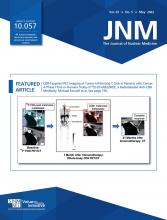TO THE EDITOR: We have read with interest the paper by Zaragori et al. about the role of PET using 6-18F-fluoro-L-DOPA (18F-FDOPA) in the prediction of molecular parameters by radiomics (1). We agree that radiomics is a promising approach to improve the accuracy of amino acid PET (2). This has been demonstrated, for example, for the differentiation of recurrent tumor from treatment-related changes (3,4).
Zaragori et al. report that radiomics features of static and dynamic 18F-FDOPA data in patients with a neuropathologic diagnosis of grade II, III, or IV glioma were able to predict IDH mutations and the 1p/19q codeletion with an area under the curve of 0.831 and 0.724, respectively. The authors conclude that 18F-FDOPA PET using a full set of radiomics features is an effective tool for the noninvasive prediction of IDH mutations and for prediction of the 1p/19q codeletion in routine practice.
Although we have no doubt about the quality of the study, we would like to point out a problem with the preselection of patients. For this study, 74 patients with grade II–IV gliomas were retrospectively selected from a larger collective. The authors assume that the results of the study are valid for the noninvasive prediction of molecular parameters in patients with suspected glioma, that is, in the setting of preoperative diagnostics in which, apart from clinical and radiologic parameters, no information is available about the histology of the tumors.
Previous studies investigating the final diagnosis of patients referred for amino acid PET with suspected brain tumor, however, reported that 20%–40% had benign lesions or nonglial tumors (e.g., inflammation, ischemia, or lymphoma) (5–7). The radiomic features of these lesions were not considered in the present analysis and could significantly affect the results of the study. Therefore, the validity of the study for noninvasive prediction of molecular parameters in the setting of preoperative diagnostics is at least doubtful.
A similar issue could also be observed in another recently published study (8), which investigated the prediction of TERTp mutation status in IDH wild-type (IDHwt) high-grade gliomas using pretreatment dynamic O-(2-18F-fluoroethyl)-l-tyrosine (18F-FET) PET radiomics. In that study, patients with IDHwt tumors were selected from a mixed population of patients, and the authors reported that radiomics based on time-to-peak images extracted from dynamic 18F-FET PET scans could predict the TERTp mutation status of IDHwt diffuse astrocytic high-grade gliomas with high accuracy preoperatively. Since the IDH mutation status in the preoperative population is not known, the analysis is considerably affected by the IDH-negative gliomas and benign lesions, and the validity of this study also—in the setting of preoperative diagnostics—has to be viewed with great caution.
Summarizing, we would like to point out that image analysis methods aiming at noninvasive prediction of molecular parameters have to be based on a representative preoperative population. Preselection of such populations based on postoperative histologic data leads to an erroneous and not clinically useful conclusion.
We conclude that the results of such studies can be considered only as hypotheses and have no relevance for clinical practice.
Footnotes
Published online Jan. 27, 2022.
- © 2022 by the Society of Nuclear Medicine and Molecular Imaging.







